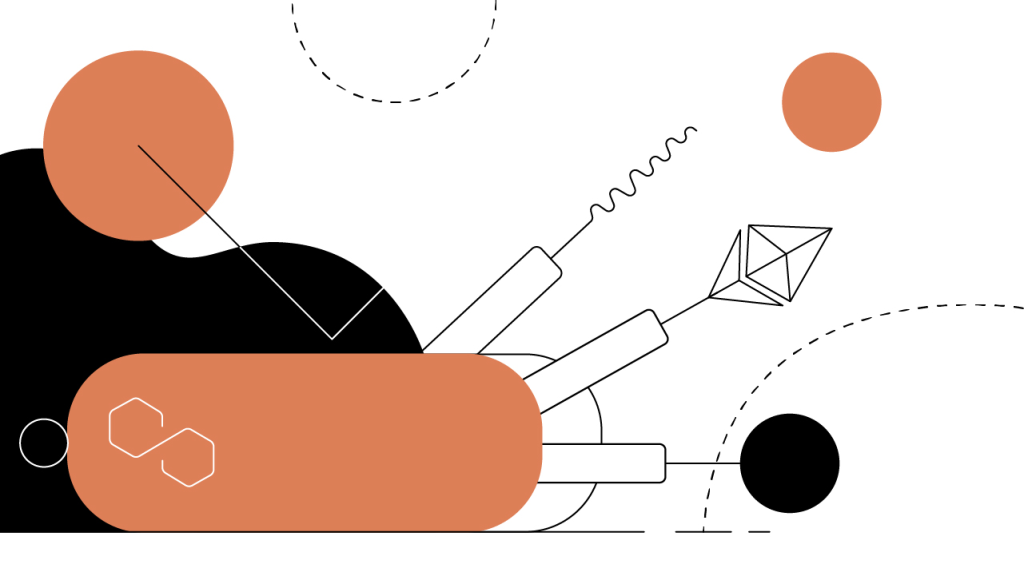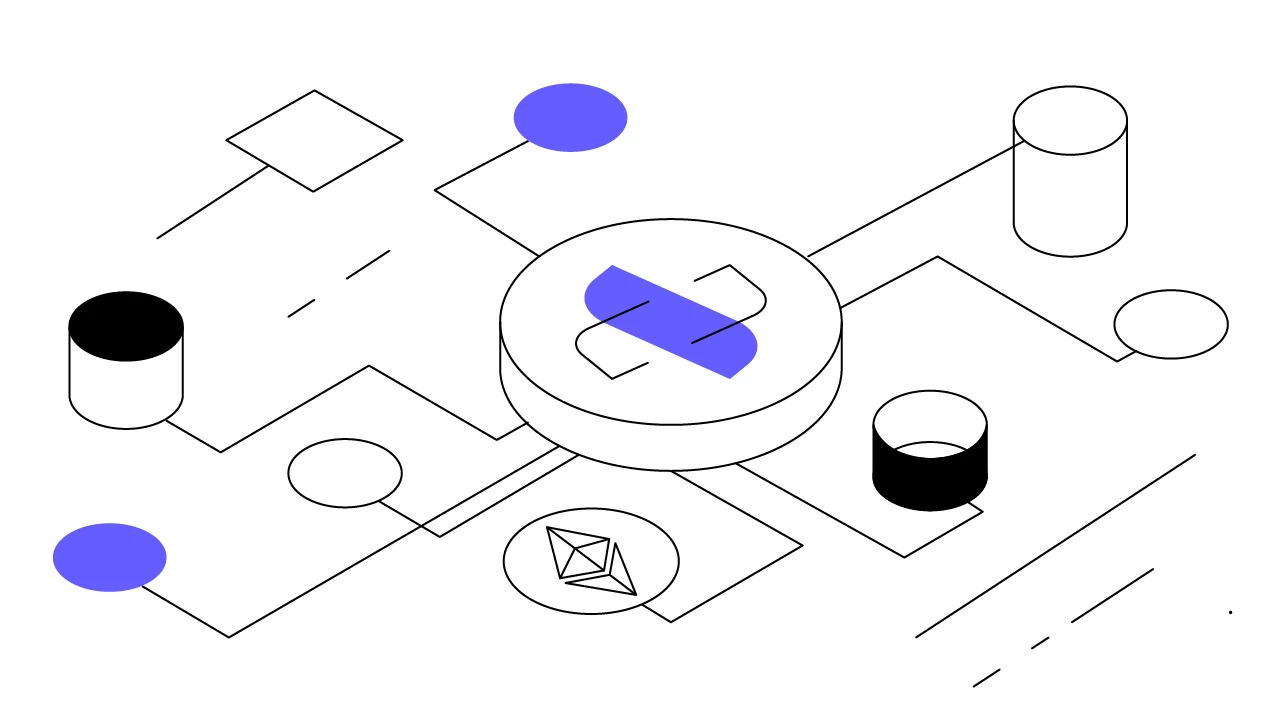Contents
Polygon (MATIC): The Swiss Army Knife of Ethereum Scaling
A look at Polygon (formerly Matic Network), a Layer-2 scaling solution with payment and lending solutions, atomic swaps, and improved dApp and DEX performance.
By Sandeep Nailwal, Co-Founder & COO, Polygon
Updated October 10, 2023 • 5 min read

Summary
Formerly known as Matic Network, Polygon improves the functionality of the Ethereum blockchain by drastically increasing its network scalability and overall transaction speed. Polygon uses its own Proof-of-Stake (PoS) blockchain and Commit Chain connectivity to help scale the Ethereum network, and seeks to solve inefficiencies that may hinder widespread adoption of blockchain technology.
Polygon Crypto Network Basics
Polygon is a Layer-2 scaling solution created to help bring mass adoption to the Ethereum platform. It caters to the diverse needs of developers by providing tools to create scalable decentralized applications (dApps) that prioritize performance, user experience (UX), and security. Polygon achieves this in large part due to the underlying technical architecture of its Proof-of-Stake (PoS) Commit Chain and its More Viable Plasma (MoreVP) L2 scaling solution. Polygon’s PoS blockchain serves as a Commit Chain to the Ethereum mainchain, attracting over 80 Ethereum dApps to its platform that transact without instances of the network congestion common to Ethereum and other Proof-of-Work (PoW) blockchains.
Polygon functions primarily through Commit chains, which are transaction networks that operate adjacent to a main blockchain — in this case Ethereum. The Commit chains bundle together batches of transactions and confirm them en masse before returning data to the main chain. Theoretically, Polygon will eventually have thousands of chains scaling together to increase throughput, with the potential to one day generate millions of transactions per second (TPS) when attached to a mainchain like Ethereum. Polygon currently only makes use of Commit Chain connectivity to improve transaction times, but will eventually make use of other Layer-2 scaling mechanisms such as Optimistic Rollups.
Although entirely focused on Ethereum at present, Polygon plans to develop its scalability-focused product offering to support other blockchains, and to provide cross-chain interoperability between different protocols.
Matic Token and Matic Wallet
The Matic token (MATIC) is Polygon’s native token, and has several distinct uses, one of them being to power the protocol via a gas-based mechanism used to pay network fees accrued from the computational power the network exerts to transfer data. This mechanism also allows software developers and ecosystem contributors to build dApps on Polygon by paying MATIC tokens to use the platform and its development framework.
MATIC can be stored in the Matic Wallet, instantly giving holders the option to stake their tokens and manage their own investments directly. Matic Wallet is designed using Polygon’s MoreVP technology as an easy-to-use solution for MATIC token holders to securely and simply manage their crypto finances. The wallet is built to be lightning-fast and integrate with WalletConnect to ensure the safekeeping of a user’s private keys, and to provide access to other Polygon features. The wallet also allows users to connect with various dApps, stake their MATIC tokens, and hold other ERC-20 tokens.
In the future, Polygon hopes to expand beyond Ethereum and be used for other blockchains that are creating their own decentralized finance (DeFi) ecosystems. To enable the mass adoption of DeFi, new blockchain infrastructure must be built in a decentralized, immutable, and trustless manner with high scalability and the ability to deliver cheap, fast transactions — a challenge that Polygon hopes to address.
Real-World Uses of The Polygon Crypto Network
Payments: The Polygon crypto platform is designed to allow dApps to speed up payments, enabling nearly instant payment settlement through specialized application programming interface (API) and software development kit (SDK) integration. This process allows dApps, merchants, and users to instantly accept or pay in any type of cryptocurrency — though usually in ERC-20 tokens or ETH. This system is being rolled out in three distinct phases:
Ethereum (ETH) and ERC-20 token payments
Cross-chain multi-asset token transfers and payments utilizing atomic swaps in partnership with liquidity providers
Fiat-based payment system employing fiat liquidity providers
Lending Platform: Polygon is building a mechanism to allow merchants to analyse the credit ratings of users who have signed up to use the platform by assessing their transaction history. This functionality is carried out in partnership with Dharma Protocol. The leading Lending Protocol Aave has more than $1B liquidity locked on its Polygon markets with more than 8000 users.
Games: Polygon’s Layer-2 sidechain scaling solution stands to make blockchain-based gaming faster and perform better. Blockchain gaming lags behind traditional PC and console gaming systems because of poor transaction speed and high network latency. With Polygon’s Commit Chain scaling technology and the Ethereum network working together, developers and gamers will be able to build and play games more effectively. Polygon’s ability to help grow the blockchain gaming industry could not come at a better time, as non-fungible tokens (NFTs) and NFT marketplaces are driving the popularity of the blockchain and crypto industry at large — with many gamers buying, selling, and trading different types of in-game NFTs. Top Gaming and NFT Dapps like Aavegotchi, Neon District, Zed Run, and Cometh have scaled their user experiences with Polygon.
Other Use Cases: Polygon is also built for many other use cases, like helping realize the fast settlement times needed to allow decentralized exchanges (DEXs) to offer users faster and cheaper trading. Quickswap, Dfyn and ComethSwap are some of the Polygon DEXs that are witnessing high volumes and user activity. Protocols like Curve and mStable have also ensured low cost and low slippage stablecoin swaps. Additionally, Polygon’s plasma scaling solution is able to expedite cross-chain atomic swaps of tokenized and non-tokenized assets. Most dApps need a way to sign transactions without submitting private keys due to user privacy concerns. Because of its scalability enhancements, Polygon helps enable an open identity framework for dApp design and use.
Polygon Is Expanding on Matic’s Capabilities
Originally known as Matic Network and launched in 2017, Polygon’s primary objective has always been about building Ethereum scaling architecture. Operating for several years as the Matic Network, it accomplished this with its PoS chain and plasma sidechain scaling solution. Its official transition to Polygon — announced in February 2021 — maintains the same mission, but with a newly expanded scope and set of technological ambitions within the Ethereum ecosystem.
Polygon differs from its predecessor in that it’s approach is now multi-faceted. Polygon seeks to transform Ethereum into a true multi-chain ecosystem that benefits from all kinds of Layer-2 scalability, not just the initial implementations provided by the Matic Network. Polygon presents a suite of solutions to Ethereum’s scalability crisis — hence the ‘poly’ portion of the project’s updated nomenclature. Polygon still deals primarily with sidechain connectivity and runs its main PoS chain as of April 2021, but it has plans to expand its toolbox to include other Layer-2 solutions like zkRollups and Optimistic Rollups, standalone sidechains, enterprise chains, shared security chains, as well as interchain communication protocols. As such, Polygon describes itself as a Swiss Army knife of Ethereum scaling and infrastructure development.
It is important to note that Polygon’s already-proven infrastructure — its PoS chain and plasma sidechains — will continue uninterrupted. Polygon’s new additions and scaling solutions will be entirely built around these cornerstones. Polygon’s scaling solutions have so far seen widespread adoption with 250+ Dapps, ~20M+ txns and ~390K unique wallet users.
With the development of additional scaling infrastructure and a full-fledged multi-chain ecosystem, Polygon hopes to transform Ethereum into an ‘Internet of Blockchains.’ Polygon also now enjoys more direct support from major Ethereum developers than ever before with several Ethereum community members joining Polygon in advisory roles — a welcome advantage to the project’s ongoing development and success. While Polygon’s roadmap is ambitious, the project has accrued the technology, support, and experience to deliver on its promises. Though the extent to which Polygon can help scale the Ethereum network remains to be seen, the benefits of doing so cannot be understated.
Cryptopedia does not guarantee the reliability of the Site content and shall not be held liable for any errors, omissions, or inaccuracies. The opinions and views expressed in any Cryptopedia article are solely those of the author(s) and do not reflect the opinions of Gemini or its management. The information provided on the Site is for informational purposes only, and it does not constitute an endorsement of any of the products and services discussed or investment, financial, or trading advice. A qualified professional should be consulted prior to making financial decisions. Please visit our Cryptopedia Site Policy to learn more.

Author
Sandeep Nailwal
Co-Founder & COO, Polygon
Sandeep Nailwal is the Co-Founder and COO of Polygon. Sandeep discovered the revolutionary nature of blockchain in 2017 and set his sights on solving for scalability issues with the founding of Matic Network (now Polygon) alongside Jaynti Kanani and Anurag Arjun. His main responsibilities include spearheading branding, marketing, adoption, operations, and stakeholder partnerships in service of pushing forward the vision of Polygon.
Is this article helpful?


